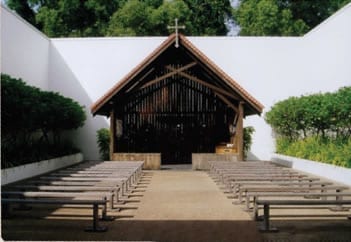Singapore was considered a strategic military base and an important territory of the British Empire. The fall of Singapore in February 1942 was seen as one of the greatest defeats for the British Army. The speed and ferocity of the Japanese attack caught many military advisors by surprise including Britain’s Prime Minister, Winston Churchill.
Of the 50,000 troops captured in Singapore on the 15th February 1942, 14,972 of the soldiers were Australian. They were exhausted and their numbers severely depleted following heavy fighting on the Malay Peninsula. The Australians, along with their comrades from the British and Indian armies, had withdrawn from the Malay Peninsula to defend Singapore from the advancing Japanese army. The British command ordered allied forces to defend a 70 mile coast line, a near impossible task considering the severely depleted number of troops.
Australians in Changi
In January 1942, prior to the surrender, Royal Australian Air Force (RAAF) squadrons had been evacuated and Royal Australian Navy (RAN) warships were ordered to leave Singapore. The remaining 65 Australian Army nurses stationed in Singapore were also ordered to evacuate aboard the SS Vyner Brook, a British ship. Their colleagues, who had sailed the previous day, all arrived home safely.
The SS Vyner Brook took a direct hit from Japanese bombers and those who survived made their way on-shore to Banka Island in the strait between Sumatra and Banka. Civilians, wounded soldiers and nurses surrendered to the Japanese and were machine gunned on the beach: only one nurse survived; Vivian Bullwinkel
On 15th February 1942 the British Commander in Singapore General Arthur Percival signed the instrument of surrender. 14,972 Australian soldiers were marched through the streets of Singapore to the Changi prison and on to the Selerang barracks, a former British army base, which was to be their home for the next three and a half years.
By 1943 only 2,500 Australian prisoners remained, the others having been transported in “hell ships” to be used as forced labour on the Thai-Burma Railway and in steel works, copper and coal mines in Taiwan, Burma, Borneo and Japan.
Conditions in Changi were indescribable. Food was scarce, disease endemic, torture and beheadings prevalent.
Allied Troops liberated Changi on 5th September 1945. This followed the unconditional surrender by the Japanese on 2nd September 1945.
FORCES (Work Parties)
From early May 1942 work parties were sent away from Singapore. These parties were called Forces, and given a letter of the alphabet, “A” Force, “B” Force etc. Officers and other ranks were in every Force sent away.
“A” Force sent away in May 1942 the majority to Burma
“B” Force sent away in July 1942 to Sandakan
Senior Officers Party sent away August 1942 to Japan via Formosa and Korea
Senior Officers Party sent away August 1942 to Formosa and Korea
“C” Force sent away November 1942 to Japan and in January 1943 approximately 1,400 men sent to Burma
“D” Force sent away March 1943 to Burma
“E” Force sent away March 1943 to Borneo
“F” Force sent away April 1943 to Thailand
“G” Force sent away April 1943 to Japan
“H” Force sent away May 1943 to Thailand
“J” Force sent away June 1943 to Japan
“K” Force sent away June 1943 to Thailand
“L” Force sent away June 1943 to Thailand

